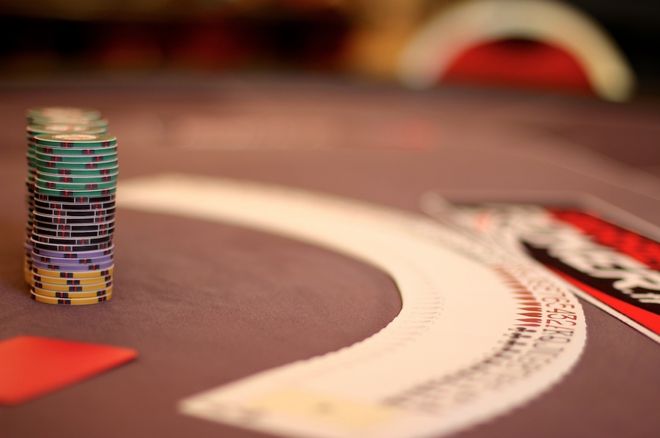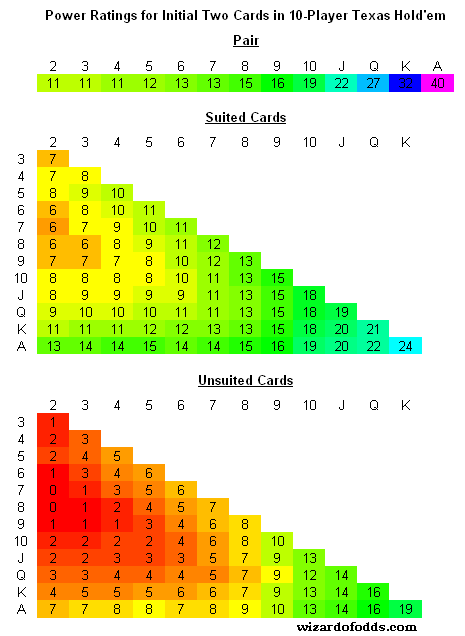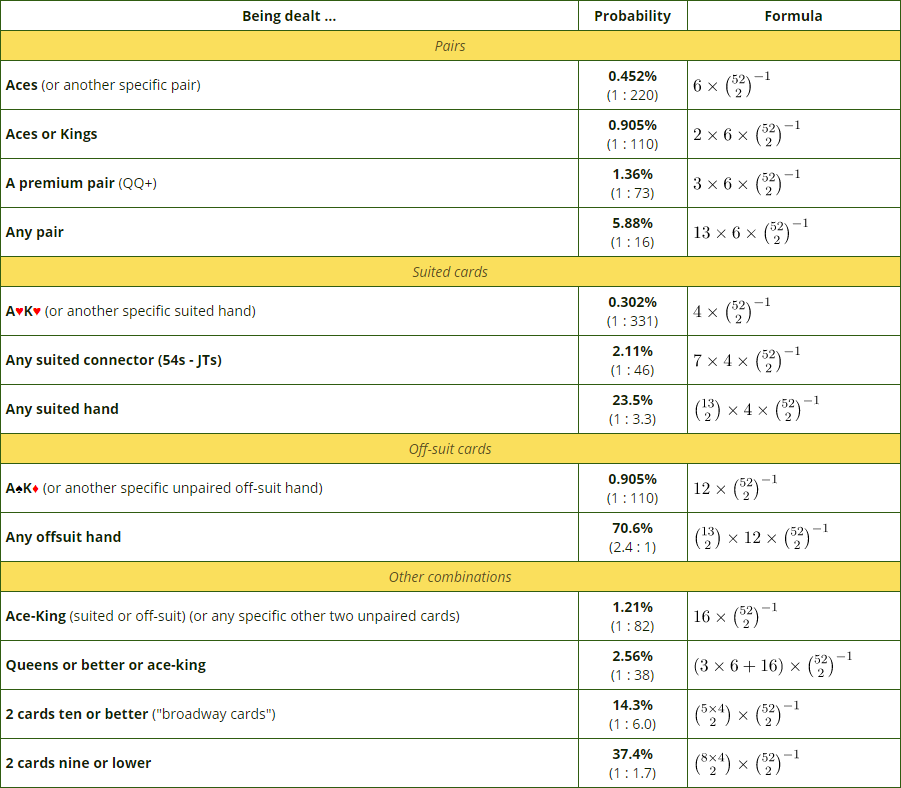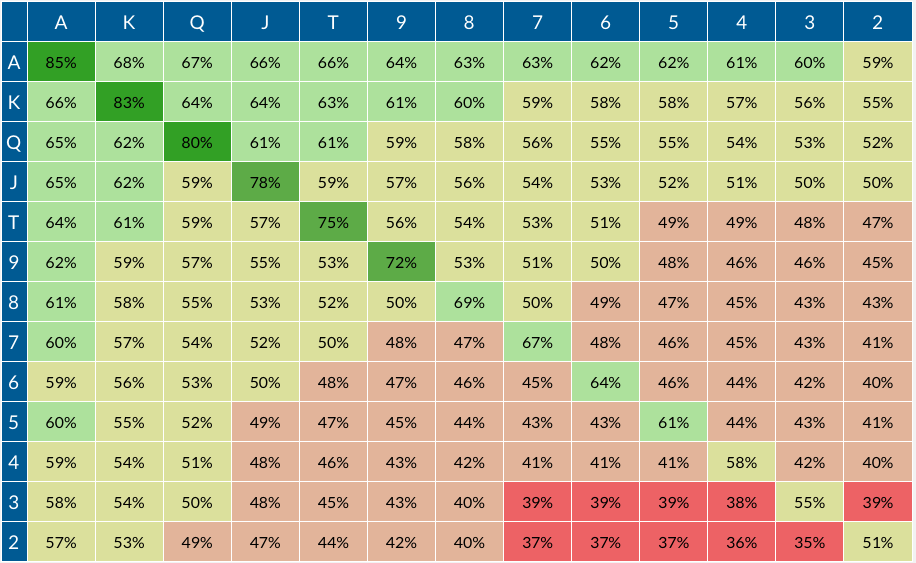What Are The Odds Of Hands In Poker
Poker Starting Hands - Comprehensive guide to which poker hands you should play, including a 2021 Texas Hold'em poker starting hands chart. Poker odds refer to the probability of an event happening and allow you to work out how much money you could make if your hand wins. Good odds mean a higher chance of success are calculated based on the equity of your hand. The higher the odds against you the lower your chances of winning. With nine outs and 46 cards unknown, there are nine cards that will let you win the hand and 37 cards (46 unseen cards - 9 winning cards) that will cause you to lose. Thus the odds of you getting. The odds of winning reduce if more players are involved in the hand. Against two opponents holding random hands, AA wins 73.5% of the time. Against three, the odds of winning are now merely 64%. The tool I am using to show you the% is called Equilab.
- Pot Odds Calculator In Omaha
- Poker Hand Odds Calculator Preflop
- What Are The Odds Of Hands In Poker Chart
- What Are The Odds Of Hands In Poker For Beginners
- Hold Em Poker Hand Odds
- What Are The Odds Of Hands In Poker
Want to find out the probabilities of being dealt an ace before the flop in Texas Hold'em? Use the tables below to help you find the different aces odds based on the situation and the number of players at the table.
Aces probabilities odds charts.
| # Players | % Odds |
|---|---|
| 2 | 18% |
| 3 | 40% |
| 4 | 50% |
| 5 | 59% |
| 6 | 66% |
| 7 | 73% |
| 8 | 78% |
| 9 | 83% |
| # Players | % Odds |
|---|---|
| 2 | 12% |
| 3 | 23% |
| 4 | 32% |
| 5 | 41% |
| 6 | 50% |
| 7 | 57% |
| 8 | 64% |
| 9 | 69% |
| # Players | % Odds |
|---|---|
| 2 | 16% |
| 3 | 29% |
| 4 | 41% |
| 5 | 51% |
| 6 | 60% |
| 7 | 68% |
| 8 | 74% |
| 9 | 80% |
Probability of being dealt an ace in any Texas Hold'em game is 15%.
How to use aces odds.
These tables are not going to be of much use to you whilst you play, but it is useful information on the probabilities of hands with aces turning up at your table.
The most useful information from these aces odds tables is that the likelihood of a player being dealt an ace increases with the number of players at the table.
The likelihood of another player holding an ace if you hold an ace yourself table (top right) is interesting. There is a fairly high probability that another player at a 9-seater table holds an ace if you do as well. This means that we should be cautious when dealt weak aces and should fold them in early position. There is a chance that we were the only player at the table holding an ace, but we are saving ourselves more money in the long run for when we come up against another player with a better ace than ours.
Playing aces in Texas Hold'em.
An ace is the highest ranking card in Texas Hold'em and can be played either high or low. This means that if you are dealt an ace preflop, there is a fair chance that you hold one of the strongest hands at the table. If you are all-in with an opponent and they do not have a pocket pair or a better ace, you are the favorite to win the hand.
However, you should be careful to not become overly attached to the hand when you are dealt an Ace, because there is a fair chance that you will lose a sizeable proportion of your stack if you get into a hand with another player that holds a better ace than you (e.g. A9 vs AQ).
Be careful to not overvalue hands with aces, as they can get you in to a lot of trouble if you do not have a good kicker.
For strategy guides on how to play hands with aces, take a look at the rag aces and pocket aces articles.
Go back to the poker odds charts.
Can You Afford Not To Use
Poker Tracker 4?
“I wouldn’t play another session of online poker without it”
“I play $25NL, and in under 1 week PT4 had paid for itself”

Comments
This post is aimed at poker newcomers who understand how to play but lack the knowledge of the intricacies of odds and probability in the game. Since Texas holdem is the most popular poker game in the United States now, I’ll use that game for all of the examples.

If you want to win a poker game at home, in a casino cardroom, or at one of the best US casinos, you need to understand how the odds work. Don’t worry, though, they’re not as confusing as you might think.
1 – What Are Poker Odds?
If you place a bet that pays off at 2 to 1 odds, it means that if you bet $1 and win, you get $2 in winnings. You could say that odds are a ratio of how much money you’ll win if you place a bet contrasted with how much money you’ll lose.
But the term is also used to describe the probability that something will happen.
In this respect, odds are just a way of re-phrasing a probability, which is a fraction. The fractional equivalent of 2 to 1 odds is 1/3, or 33.33%. If you’re good at probability math, you can convert odds from one format to another.
Here are a couple of other things to consider when discussing or thinking about odds:
An event’s probability is always a number between 0 and 1. Also, when you add up the probability that something will happen with the probability that something won’t happen, you’ll always get a total of 1.
So, if something only has a 1/3 probability of happening, it has a 2/3 probability of NOT happening.
Finally, odds and probabilities can be reduced, just like fractions. If something has a 4/6 probability of happening, that’s the same thing as having a 2/3 probability of happening.
2 – Why Are Odds Important in US Poker?

One of the ways to win in poker is to repeatedly put yourself into what’s called +EV situations and repeatedly avoid -EV situations.
What does that mean? Well, +EV means a bet with positive expectation value, and –EV refers to a bet with negative expectation value.
The way you calculate the expected value of a bet is to compare the odds of winning with the payout odds for the bet.

In poker, the payout odds are represented by the pot odds. The amount of money in the pot compared to the amount of money it costs you to stay in the hand are the pot odds.
Here’s an example:
There’s $50 in the pot. Someone before me has bet $10. If I call, the pot pays me $50 on a $10 call. That’s 5 to 1 odds.
If I think I can win that hand 1 time out of 6, that’s even money. If I can win that hand 1 time out 5, I will profit in the long run, even though I’ll still lose most of the time. And if I figure I can only win that hand 1 time out of 7, I’ll lose money in the long run.
The thing about odds in poker is you don’t know what your opponents’ cards are. If, for example, I have the seven and the eight of hearts, I have suited connectors. Let’s say I snuck into the hand, and the flop comes with two cards that are also hearts.
I have four cards to a flush, which is a strong hand. Since there are 13 cards in each suit, there are nine cards in the deck which will fill my flush.
Since I know there are 47 cards left unaccounted for, the odds of getting another heart are 9/47, which is close to 5 to 1 odds. But I also have to account for the possibility that someone else will have a higher flush or a better hand.
If I had the ace and the king of hearts, I’d be almost a lock if I hit my flush. But with middle suited connectors like that, it’s trickier. I do know, though, that I need at least 5 to 1 pot odds to make it worth calling here.
Also, I get two shots at it—the turn and the river—so really, I don’t even need that.
Pot Odds Calculator In Omaha
3 – The Concept of Outs in Poker
Those nine cards that were hearts are my “outs.” Those are cards that will make your hand the winner.
The problem with outs is that you should discount them sometimes. In the example I gave above, where one of your opponents might have a higher flush, you might only count those nine outs as five outs, making the pot odds you’d need for a call that much higher.
Also, outs vary based on what your opponent is holding, but you don’t know what cards your opponent has.
For example, a tight player who raises from early position probably has a monster—aces, kings, or ace-king suited. You might give him an 80% probability of that holding. You might put him on a 20% probability of having a pair of jacks or queens.
A loose player, on the other hand, might have anything, but you still put him on a range of hands. You might conclude that there’s a 50% probability that he has nothing worth having at all, and maybe he flopped a small or medium pair.
This is why you discount the outs, to contend with the idea that even if you make your hand, it might not be good enough to beat your opponent at the showdown.
You could just fold until you got the absolute nut hand, but you’ll lose money from the blinds if you use that strategy.
4 – There Are Shortcuts, Too
One of the ways to get a rough estimate of your probability of hitting your hand is to multiply your number outs by four on the flop and by two on the turn. That’s the percentage chance of hitting your hand.
Here’s an example:
You have four cards to an outside straight draw. This means that there are eight cards that will fill your straight. If you’re on the flop, the probability that you’ll fill your straight is 4 x 8, or 32%. If you’re on the turn, the probability that you’ll fill your straight is 16%.
That’s roughly 2 to 1 odds and roughly 4 to 1 odds at those stages of the game, so those are the odds you’re looking for when calculating pot odds.
Poker Hand Odds Calculator Preflop
5 – Poker Bluffing
What Are The Odds Of Hands In Poker Chart
When you add bluffing to the equation, the calculation of odds and probabilities gets even more complex. You might have an idea based on your observations about how likely someone is to fold in the face of your naked bluff, or you might not. If you don’t, you shouldn’t bluff.
The problem is that bluffing is rarely a profitable move against more than two opponents. That’s because for a bluff to succeed, everyone has to fold except you.
If you’re facing two players who you think have nothing in their hands, and who you estimate have a roughly 60% probability of folding, the probability that BOTH will fold is 60% X 60%, or 36%.
So, you need 3 to 1 odds from the pot to make that a profitable bluff.
What Are The Odds Of Hands In Poker For Beginners
The probability drops to 36% X 60%, or about 22%. Now you need 4 to 1 or 5 to 1 pot odds to justify bluffing.
A semi-bluff is a better strategy. The idea behind a semi-bluff is that you bet and/or raise with a hand which probably isn’t the best hand now, but if you get the right cards, it will be.
You have two ways to win—if you make your hand, AND if your opponents all fold.
Hold Em Poker Hand Odds
If you have a roughly 36% probability of filling a straight and a 22% probability that everyone will fold when you bet or raise, you’ll win that hand 58% of the time. Even if it’s even money when it comes to pot odds, your move is going to be wildly profitable here.
Conclusion
What Are The Odds Of Hands In Poker
Odds, probability, and counting outs are integral to a solid poker strategy. It’s not enough to just play tight aggressive poker, not anymore. You also need to know when to get your money into the pot for +EV situations on a consistent basis.